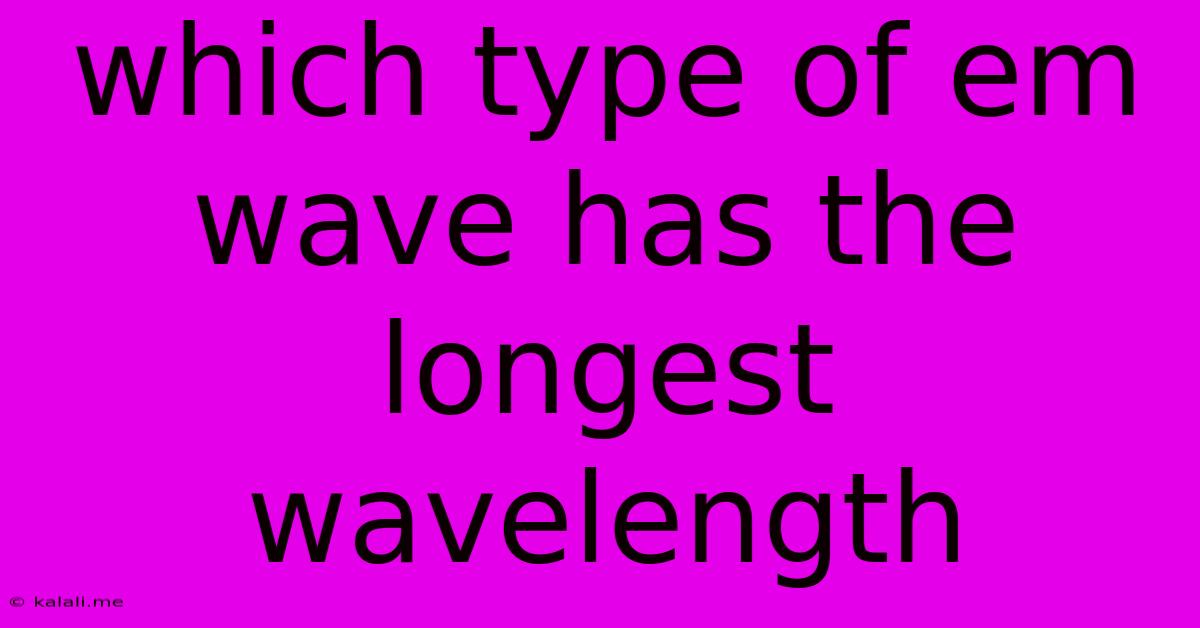Which Type Of Em Wave Has The Longest Wavelength
Kalali
Jun 16, 2025 · 2 min read

Table of Contents
Which Type of EM Wave Has the Longest Wavelength?
Radio waves boast the longest wavelengths within the electromagnetic (EM) spectrum. This article delves into the characteristics of radio waves, their position within the EM spectrum, and how their wavelength compares to other types of electromagnetic radiation. Understanding the electromagnetic spectrum and the properties of its various components is crucial for anyone interested in physics, astronomy, or telecommunications.
Radio waves are a form of electromagnetic radiation with wavelengths ranging from millimeters to hundreds of kilometers. This incredibly broad range encompasses various sub-bands, each with its own applications. Their long wavelengths allow them to travel long distances with minimal attenuation, making them ideal for broadcasting and communication technologies. This is in stark contrast to shorter wavelengths, which are more easily absorbed or scattered.
The Electromagnetic Spectrum: A Brief Overview
The electromagnetic spectrum encompasses all types of electromagnetic radiation, arranged according to their wavelengths (or equivalently, frequencies). From longest to shortest wavelength, the spectrum includes:
- Radio Waves: As discussed, these have the longest wavelengths.
- Microwaves: Shorter than radio waves, used in ovens and communication.
- Infrared (IR): Felt as heat; used in thermal imaging and remote controls.
- Visible Light: The only portion of the EM spectrum visible to the human eye.
- Ultraviolet (UV): Causes sunburns; used in sterilization.
- X-rays: High-energy radiation used in medical imaging.
- Gamma Rays: The highest-energy and shortest wavelength EM radiation.
Why Radio Waves Have the Longest Wavelength
The wavelength of electromagnetic radiation is inversely proportional to its frequency. This means that lower frequency waves have longer wavelengths, and higher frequency waves have shorter wavelengths. Radio waves occupy the lowest frequency portion of the electromagnetic spectrum, hence possessing the longest wavelengths.
Applications of Radio Waves
The wide range of wavelengths within the radio wave spectrum allows for diverse applications, including:
- Broadcasting: Radio and television signals use radio waves to transmit information over long distances.
- Communications: Mobile phones, Wi-Fi, and satellite communication rely on radio waves for data transmission.
- Navigation: GPS and other navigation systems utilize radio waves to determine location.
- Astronomy: Radio telescopes detect radio waves emitted by celestial objects, providing insights into the universe.
- Medical Imaging: Specific radio frequencies are used in certain medical imaging techniques.
Understanding Wavelength and Frequency
It's essential to remember the inverse relationship between wavelength and frequency: λf = c, where:
- λ (lambda) represents wavelength
- f represents frequency
- c represents the speed of light (approximately 3 x 10<sup>8</sup> m/s in a vacuum)
This equation highlights why radio waves, with their low frequencies, have correspondingly long wavelengths.
In conclusion, radio waves are definitively the type of electromagnetic wave with the longest wavelength, a characteristic that makes them indispensable in various technologies and scientific fields. Their low frequency and long wavelength allow for efficient long-distance transmission, making them a cornerstone of modern communication and observation.
Latest Posts
Latest Posts
-
Which Of The Following Is A Variable Cost
Jun 16, 2025
-
Select The Correct Statement About Phylogenetic Trees
Jun 16, 2025
-
Multiples Of 6 Up To 1000
Jun 16, 2025
-
What Is Square Root Of 21
Jun 16, 2025
-
What Is The Tangent Of 90 Degrees
Jun 16, 2025
Related Post
Thank you for visiting our website which covers about Which Type Of Em Wave Has The Longest Wavelength . We hope the information provided has been useful to you. Feel free to contact us if you have any questions or need further assistance. See you next time and don't miss to bookmark.